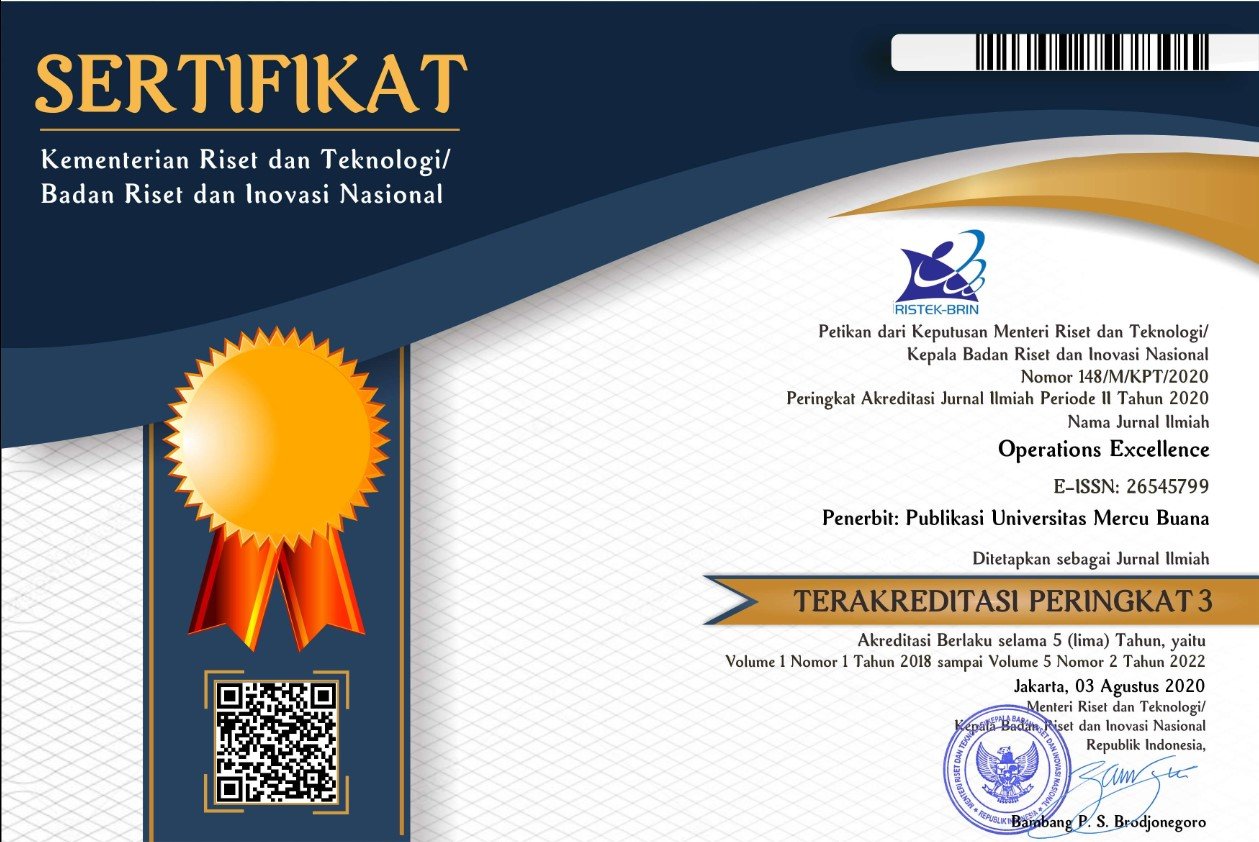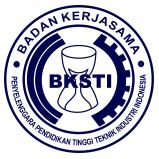Analisis Kecelakaan Kerja Dalam Upaya Menurunkan Kecelakaan Kerja Menggunakan Metode Fault Tree Analysis Di UMKM Kopi 1000 Nurhidayah
Abstract
Work accidents are one of the most common problems in companies where these accidents often occur in workers and cause severe injuries at the physical level of workers. UMKM Kopi 1000 Nurhidayah in carrying out activities cannot avoid problems that will occur, the purpose of this study is to find out the causes of work accidents that occur and provide solutions to the causes of these events. This type of research is qualitative and quantitative with primary and secondary data using the Fault Tree Analysis (FTA) method. Work accidents in UMKM Kopi 1000 Nurhidayah occur due to human factors, equipment factors, work procedures, and environmental factors. The types of accidents are falls, pinched hands, earaches, backaches, shortness of breath, tightness, eye pain, and blistered hands. The highest cause of accidents was coffee slime with a probability of 7.74% and the lowest was a work shirt with holes and broken glasses with a probability of 0.92%. The solution to the cause of work accidents is to prepare yourself physically and mentally, by periodically replacing damaged personal protective equipment to minimize the impact of work accidents, as well as the need to conduct training on safety standardization, and always maintain a clean work environment.
Keywords
Full Text:
PDFReferences
Aini, R. Q. (2021). Work Accident Analysis to Increase Work Productivity Using Failure Mode and Effect Analysis (FMEA) and Fault Tree Analysis (FTA) Methods at PT . XYZ. Budapest International Research and Critics Institute-Journal (BIRCI-Journal), 5(2), 14680–14695. https://doi.org/10.33258/birci.v5i2.5345
Arman, U. D., Melasari, J., & Suwanda, R. (2022). Identifikasi Penyebab Kecelakaan Kerja Konstruksi Menggunakan Accident Root Cause Tracing Model (ARCTM) dan Fault Tree Analysis (FTA). Cantilever, 11(1), 17–28. https://doi.org/10.35139/cantilever.v11i1.112
Asih, I., Setiawan, I., Hernadewita, H., & Hendra, H. (2022). Effects of ergonomics intervention on work accidents in the construction sector and their effect on productivity. Jurnal Sistem Dan Manajemen Industr, 6(1), 45–55. https://doi.org/http://dx.doi.org/10.30656/jsmi.v6i1.4242
Darmawan, D., Puspita, A. D., & Santosa, G. (2022). Analisis Keselamatan Dan Kesehatan Kerja Dengan Pendekatan Hazard Identification Risk Assessment and Fault Tree Analysis Pada PT. WGI. Journal of Industrial and Systems Optimization, 5(1), 10–17. https://doi.org/10.51804/jiso.v5i1.10-17
Ekoanindiyo, F. A., Yohanes, A., Prihastono, E., & Hayati, E. N. (2021). Pendekatan Metode Fault Tree Analysis Dalam Kesehatan Dan Keselamatan Kerja Serta Pengaruhnya Terhadap Produktifitas. Jurnal Rekayasa Sistem Industri, 7(1), 20–25. https://doi.org/10.33884/jrsi.v7i1.4456
Fauziah, S. R., Renosori, P., & Selamat. (2022). Identifikasi Penyebab Terjadinya Kecacatan pada Produk Induktor Toroidal dengan Menggunakan Metode Fault Tree Analysis (FTA) di CV. Cipta Karya Mandiri. Bandung Conference Series: Industrial Engineering Science, 2(1), 91–99. https://doi.org/10.29313/bcsies.v2i1.1619
Haslindah, A., Idrus, I., Rosliadi, R., & Irsyad, A. (2019). Analisa Penerapan Progam Keselamatan Kerja Dalam Usaha Meningkatkan Produktivitas Kerja Dengan Pendekatan Fault Tree Analysis. ILTEK : Jurnal Teknologi, 13(02), 1971–1975. https://doi.org/10.47398/iltek.v13i02.371
Kurniawan, R. A., & Rizqi, A. W. (2022). Analisa Manajemen Resiko Dengan Metode Fault Three Analisys (FTA) System Compressor Air Minum Dalam Kemasan PT. Swabina Gatra. Jurnal Teknovasi, 9(1), 1–9. https://doi.org/10.55445/teknovasi.v9i1.657
Putri, D. I., & Ngatilah, Y. (2021). Analisis Kualitas Produk Console Table dengan Menggunakan Metode Fault Tree Analysis (FTA) dan Failure Mode and Effect Analysis (FMEA) di PT. Romi Violeta Sidoarjo. Juminten : Jurnal Manajemen Industri Dan Teknologi, 2(5), 97–108. https://doi.org/10.33005/juminten.v2i5.322
Rahmanto, I., & Hamdy, M. I. (2022). Analisa Resiko Kecelakaan Kerja Karawang Menggunakan Metode Hazard and Operability (HAZOP) di PT PJB Services PLTU Tembilahan. Jurnal Teknologi Dan Manajemen Industri Terapan (JTMIT), 1(2), 53–60.
Sari, S., Puspita, A., Sulistiyo, T., Faruq, M. A., & Bimantyo, R. (2022). Analisis Potensi Bahaya Serta Rekomendasi Perbaikan Dengan Metode HAZOP Dan 5S (Studi Kasus: Percetakan PT. XYZ). MATRIX : Jurnal Manajemen & Teknik Industri - Produksi, 22(2), 139–148. https://doi.org/10.350587/Matrik v22i2.3070
Septania, L. A. D., & Deswindi. (2022). Quality Control of Frozen Fish Based on Fault Tree Analysis (FTA) and Failure Mode and Effect Analysis (FMEA) Methods. International Journal of Education, Information Technology and Others (IJEIT), 5(2), 86–92. https://doi.org/10.5281/zenodo.6585742
Septianto, A., & Wardhani, A. R. (2020). Penerapan Analisis Resiko Terhadap Kesehatan Dan Keselamatan Kerja(K3) Pada PT. X. Jurnal Aplikasi Dan Inovasi Ipteks Soliditas, 3(1), 6–11. https://doi.org/10.31328/js.v3i1.1385
Setiawan, I., Aldrianto, N. F., Arifin, D., Fipiana, W. I., & Lusia, V. (2022). The effect of occupational health and safety on the performance of employee of Tire Industry Indonesia. Journal Industrial Servicess, 7(2), 253–258. https://doi.org/10.36055/jiss.v7i2.14034
Suseno, S. I. K. (2022). Pengendalian Kualitas Cacat Produk Tas Kulit Dengan Metode Failure Mode and Effect Analysis (FMEA) dan Fault Tree Analysis (FTA) di PT. Mandiri Jogja Internasional. Jurnal Cakrawala Ilmiah, 1(6), 1307–1320. https://doi.org/https://bajangjournal.com/index.php/JCI/article/view/1131
Syahabuddin, A., & Zulziar, M. (2021). Analisis Defect Produk Viro Core Collection dengan Metode Fault Tree Analysis, Analisis Faktor dan Perbandingan. Jurnal INTECH, 7(1), 23–29. https://doi.org/10.30656/intech.v7i1.2695
Triswandana, I. W. G. E., & Armaeni, N. K. (2020). Penilaian Risiko K3 Konstruksi Dengan Metode HIRARC. Ukarst : Universitas Kadiri Riset Teknik Sipil, 4(1), 96–108. https://doi.org/10.30737/ukarst.v3i2
Wahid, M., & Hasibuan, S. (2021). Performance evaluation of after-sales service partners in the power tools industry. Jurnal Sistem Dan Manajemen Industri, 5(2), 105–114. https://doi.org/10.30656/jsmi.v5i2.3985
Widodo, D. S. (2021). Keselamatan dan Kesehatan Kerja (K3): Manajemen dan Implementasi K3 di Tempat Kerja (1st ed.). Penebar Media Pustaka. https://books.google.co.id/books/about/Keselamatan_dan_Kesehatan_Kerja_Manajeme.html?id=1CEgEAAAQBAJ&redir_esc=y
Zazilah, A. N., & Rusmawan, P. N. (2021). Analisis Defect Gula Semut Dengan Metode Fault Tree Analysis Sebagai Industri Kreatif. Seminar Nasional Terapan Riset Inovatif (SENTRINOV) Ke-6, 7(2), 345–353.
DOI: http://dx.doi.org/10.22441/oe.2022.v14.i2.053
Refbacks
- There are currently no refbacks.
Copyright (c) 2022 Operations Excellence: Journal of Applied Industrial Engineering

This work is licensed under a Creative Commons Attribution-ShareAlike 4.0 International License.
Journal ISSN:
| Print ISSN: 2085-4293 | |
| Online ISSN: 2654-5799 |
Tim Editorial Office
Operations Excellence: Journal of Applied Industrial Engineering
Magister Teknik Industri Universitas Mercu Buana
Jl. Raya Meruya Selatan No. 1 Kembangan Jakarta Barat
Email: [[email protected]]
Website: http://publikasi.mercubuana.ac.id/index.php/oe
Journal DOI: 10.22441/oe
The Journal is Indexed and Journal List Title by:

.png)
.png)
.png)


Operations Excellence: Journal of Applied Industrial Engineering is licensed under a Creative Commons Attribution-NonCommercial-ShareAlike 4.0 International License.










